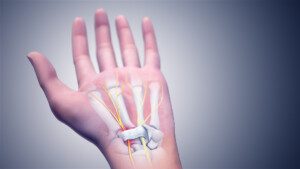Forearm workouts involve a lot of tension in the wrist area, which is where carpal tunnel syndrome occurs.
People who do a lot of forearm strength training may wonder if over time, this could possibly cause a development of carpal tunnel syndrome.
The area of compression on the median nerve is at the wrist.
Workouts that engage the forearms include the following:
- Hammer curl
- Reverse curl
- Dumbbell wrist roll
- Barbell wrist flexion and extension
“Forearm workouts could definitely aggravate CTS, especially if the exercises performed include a lot of end-range wrist flexion or extension positions,” says Dr. Logan Thomas, a physical therapist in Parker City, IN.
“Forearm workouts aren’t likely to cause carpal tunnel syndrome, but hypertrophy of the forearm muscles could compress the median nerve higher up in the forearm, which is called pronator teres syndrome and has similar symptoms as CTS.”
If you suspect carpal tunnel or pronator teres syndrome, you should consult with a physician.

Carpal tunnel syndrome. Scientific Animations
If you’re diagnosed with either of these conditions, and lifting weights aggravates them, you’ll need to make accommodations with your regimen to prevent the condition from getting worse.
This would mean avoiding any exercises that worsen the pain.
If the condition doesn’t improve after several months of conservative treatment, you may want to consider undergoing a carpal tunnel release.
 Dr. Thomas a physical therapist, and strength and conditioning coach who is passionate about patient education. He believes the most important and often overlooked step in the process to becoming pain-free is understanding the anatomy and biomechanics of your body.
Dr. Thomas a physical therapist, and strength and conditioning coach who is passionate about patient education. He believes the most important and often overlooked step in the process to becoming pain-free is understanding the anatomy and biomechanics of your body.
 Lorra Garrick is a former personal trainer certified by the American Council on Exercise. At Bally Total Fitness she trained clients of all ages for fat loss, muscle building, fitness and improved health.
Lorra Garrick is a former personal trainer certified by the American Council on Exercise. At Bally Total Fitness she trained clients of all ages for fat loss, muscle building, fitness and improved health.
.















